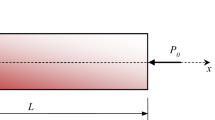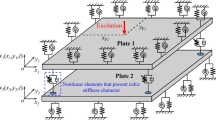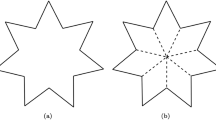Abstract
In this study, the Hamilton’s principle is applied to revisit the dynamic modeling of the cable-stayed beam, and the motion equations governing the nonlinear response of the cable-stayed beam are derived. The corresponding boundary terms are transformed to the dynamic equilibrium conditions through the continuity of the displacement at the anchoring point. Following the standard condensation procedure, the condensed model of the cable-stayed beam is determined. The eigenvalue analysis is performed to determine the closed-form eigenvalue solution of the linear problems, and two types of eigenvalue solution are obtained. It is shown that the frequency spectrum of the cable-stayed beam exhibits the curve veering and crossover phenomena. Corresponding to these phenomena, the mode shapes of the cable-stayed beam may exhibit the coupling characteristic. Finally, the discrete model of the cable-stayed beam is determined, and the possible nonlinear interactions are discussed.
Graphical abstract







Similar content being viewed by others

References
Rega, G.: Nonlinear vibrations of suspended cables. Part I: modeling and analysis. Appl. Mech. Rev 57, 443–478 (2004)
Abdel-Ghaffar, A.M., Khalifa, M.A.: Importance of cable vibration in dynamics of cable-stayed bridge. J. Eng. Mech. 117, 2571–2589 (1991)
Caetano, E., Cunha, A., Taylor, C.A.: Investigation of dynamic cable-deck interaction in a physical model of a cable-stayed bridge. Part I: modal analysis. Earthq. Eng. Struct. D 29, 481–498 (2000)
Kang, H., Guo, T., Zhao, Y.: Review on nonlinear vibration and modeling of large span cable-stayed bridge. Chin. J. Theor. App. Mech. 48, 519–535 (2016). (In Chinese)
Sun, C., Zhao, Y., Peng, J., et al.: Multiple internal resonances and modal interaction processes of a cable-stayed bridge physical model subjected to an invariant single-excitation. Eng. Struct. 172, 938–955 (2018)
Lilien, J.L., Pinto da Costa, A.: Vibration amplitudes caused by parametric excitation of cable stayed structure. J. Sound Vib. 174, 69–90 (1994)
Wang, L., Zhao, Y.: Large amplitude motion mechanism and non-planar vibration character of stay cables subject to the support motions. J. Sound Vib. 327, 121–133 (2009)
Luongo, A., Zulli, D.: Dynamic instability of inclined cables under combined wind flow and support motion. Nonlin. Dynam. 67, 71–87 (2012)
Warnitchai, P., Fujino, Y., Susumpow, T.: A non-linear dynamic model for cables and its application to a cable-structure system. J. Sound Vib. 187, 695–712 (1995)
Fujino, Y., Warnitchai, P., Pacheco, B.M.: An experimental and analytical study of autoparametric resonance in a 3DOF model of cable-stayed beam. Nonlin. Dynam. 4, 111–138 (1993)
Gattulli, V., Morandini, M., Paolone, A.: A parametric analytical model for non-linear dynamics in cable-stayed beam. Earthq. Eng. Struct. D. 31, 1281–1300 (2002)
Gattulli, V., Lepidi, M.: Nonlinear interactions in the planar dynamics of cable-stayed beam. Int. J. Solids Struct. 40, 4729–4748 (2003)
Gattulli, V., Lepidi, M.: Localization and veering in the dynamics of cable-stayed bridges. Comput. Struct. 85, 1661–1678 (2007)
Gimsing, N.J.: Cable Supported Bridges: Concept and Design, 2nd edn. Wiley, Chichester (1997)
Wang, Z., Sun, C., Zhao, Y., et al.: Modeling and nonlinear modal characteristics of the cable-stayed beam. Eur. J. Mech. A-Solid. 47, 58–69 (2014)
Luongo, A., Rega, G., Vestroni, F.: Planar nonlinear free vibrations of an elastic cable. Int. J. Nonlin. Mech. 9, 39–52 (1984)
Reddy, J.N.: Energy Principles and Variational Methods in Applied Mechanics, 2nd edn. Wiley, New York (2002)
Wang, L., Zhang, X., Huang, S., et al.: Measured frequency for the estimation of cable force by vibration method. J. Eng. Mech. 141, 1–7 (2015)
Natsiavas, S.: Mode localization and frequency veering in a non-conservative mechanical system with dissimilar components. J. Sound Vib. 165, 137–147 (1993)
Acknowledgements
The study was supported by Natural Science Foundation of Hunan Province (Grant 2018JJ2029) and Scientific Research Fund of Hunan Provincial Education Department (Grant 19B192).
Author information
Authors and Affiliations
Corresponding author
Appendix
Appendix
The other coefficients in discrete model of the cable-stayed beam are:
Rights and permissions
About this article
Cite this article
Wang, L., Zhang, X., He, K. et al. Revisited dynamic modeling and eigenvalue analysis of the cable-stayed beam. Acta Mech. Sin. 36, 950–963 (2020). https://doi.org/10.1007/s10409-020-00971-2
Received:
Revised:
Accepted:
Published:
Issue Date:
DOI: https://doi.org/10.1007/s10409-020-00971-2



